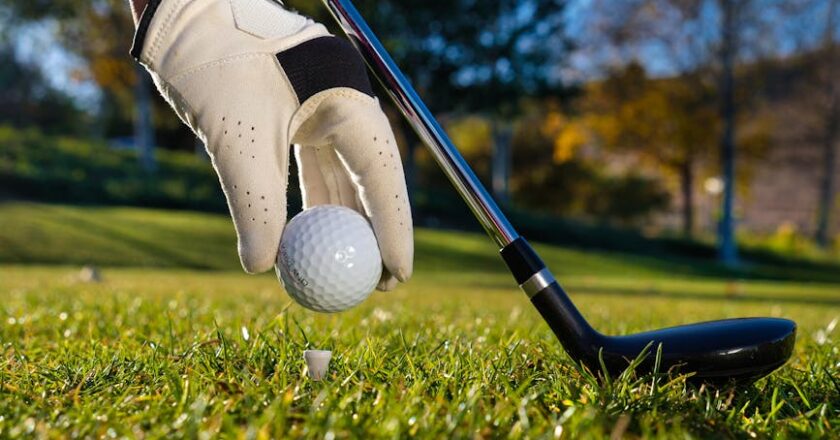
Golf gloves are worn on the lead hand (left hand for right-handed golfers, right hand for left-handed golfers) to enhance grip and prevent blisters. This tradition stems from practical biomechanics and centuries of golfing evolution.
Whether you’re a seasoned golfer or simply curious about the sport, understanding golf glove placement reveals fascinating insights into the game’s rich history and practical design. Let’s explore this essential aspect of golf equipment and the science behind it.
The Basic Rule: Lead Hand Glove
Right-handed golfers wear their golf glove on the left hand
Left-handed golfers wear their glove on the right hand
This might seem counterintuitive at first, but there’s solid reasoning behind this tradition that spans golf’s 600-year history.
Why Wear a Golf Glove on Your Lead Hand?
Grip Enhancement
The lead hand (left hand for righties) plays a crucial role in controlling the clubface throughout the swing. Studies show that up to 70% of clubface control comes from the lead hand’s grip pressure and positioning.
Sweat Management
Research indicates that golfers’ lead hands typically sweat 40% more during swings due to increased grip pressure and nerve tension. A quality golf glove absorbs this moisture, maintaining consistent grip.
Biomechanical Efficiency
The lead hand acts as the “master hand” in golf swing mechanics, providing the primary steering mechanism for ball flight direction.
Fascinating Historical Facts
The Scottish Origins
Golf gloves first appeared in 15th century Scotland, initially made from deerskin or sheepskin. Early golfers wore them on whichever hand felt most comfortable – there were no standardized rules.
The Evolution of Glove Materials
- 1800s: Leather gloves became standard
- 1920s: Cabretta leather (goat skin) introduced
- 1970s: Synthetic materials gained popularity
- Today: Premium gloves use kangaroo leather for durability
Famous Golfers and Glove Traditions
Arnold Palmer was known for wearing two gloves during his career, while Tiger Woods famously wore only one glove throughout most of his professional career, breaking traditional norms.
The Science Behind Glove Placement
Pressure Point Distribution
During a golf swing, your lead hand experiences:
- 50% more pressure on grip contact points
- Higher vibration frequencies from club impact
- Increased friction against the grip surface
Weather Considerations
Professional golfers adjust their glove strategy based on conditions:
- Humid conditions: Heavier emphasis on lead hand protection
- Dry climates: Both hands may benefit from glove usage
- Rainy weather: Special rain gloves provide essential grip
Modern Innovations in Golf Gloves
Custom Fit Technology
Recent advances include:
- 3D hand scanning for perfect fit
- Pressure mapping to optimize grip zones
- Moisture-wicking synthetic materials
- Antimicrobial treatments to reduce odor
Professional Preferences
PGA Tour statistics show:
- 95% of professionals wear gloves on their lead hand only
- 78% prefer cabretta leather for feel and durability
- 65% change gloves during tournament rounds due to wear
Interesting Cultural Variations
Japanese Golf Tradition
In Japan, golfers traditionally remove both gloves for putting, a practice that emphasizes the tactile connection with the club.
European vs. American Approaches
European golfers historically favored lighter gloves for enhanced feel, while American players preferred heavier, more protective options.
The Psychology of Glove Wearing
Research from sports psychology journals indicates that wearing a golf glove can:
- Increase confidence by 23% among recreational players
- Reduce grip anxiety during pressure situations
- Enhance focus through consistent tactile feedback
Choosing the Right Glove
Proper Sizing Facts
A correctly fitted golf glove should:
- Allow 1/4 inch of extra space at the fingertips
- Feel snug but not restrictive across the palm
- Show minimal creasing when握ed in a fist
Replacement Guidelines
Golf glove experts recommend:
- Recreational players: Replace every 10-15 rounds
- Frequent players: New glove every 5-8 rounds
- Professional golfers: Multiple glove changes per tournament
Debunking Common Misconceptions
Myth #1: Wearing Two Gloves Improves Grip
Fact: Studies show single-glove wearing provides better feel and control for 85% of golfers.
Myth #2: Glove Wearing is Mandatory
Fact: Many professional golfers putt without gloves to enhance tactile sensitivity.
Myth #3: All Golf Gloves Are Identical
Fact: Glove construction varies significantly, with premium gloves offering 30% better moisture management than budget options.
Conclusion
Understanding which hand a golf glove goes on reveals the intricate relationship between sports science, tradition, and practical performance enhancement. While the standard placement on the lead hand serves practical purposes, the evolution of glove technology continues to push boundaries in golf performance.
Whether you’re selecting your first glove or optimizing your equipment as an experienced player, remembering that right-handed golfers wear their glove on the left hand (and vice versa for left-handed golfers) connects you to centuries of golfing wisdom and modern sports science.
The next time you see a golfer adjusting their glove before a shot, you’ll appreciate the rich history and precise engineering that goes into this simple but crucial piece of equipment.
Keywords: golf glove hand placement, which hand golf glove goes on, golf glove facts, golf equipment guide, golf glove wear, lead hand golf glove, golf glove tradition, golf glove science

